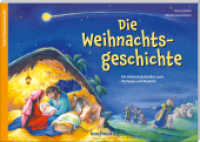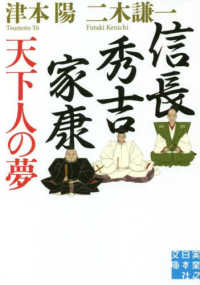Full Description
The transcultural approach to Japanese art history embraced by the contributors to this volume centers on the dynamic aesthetic, artistic, and conceptual negotiations across cultural, temporal, and spatial boundaries. It not only acknowledges material objects, people, and technologies as agents, but also intangible practices such as knowledge and concepts as vital agencies of interaction in transcultural processes. With its premise on connectivity, trans-territoriality, networks, and their transformative potential, this research destabilizes categorical configurations such as "center vs. periphery" and "high vs. low," calling into question the classical canon of Japanese art history.
Contents
Acknowledgments
List of Figures
List of Tables
Notes on Contributors
Notes to Reader
Japanese Art: Transcultural Perspectives
Melanie Trede, Mio Wakita and ChristineM.E. Guth
Part1 Methodologies, Texts, and Discourses
Commentary
Monica Juneja
1 The Origin of Species and the Rise of World Art History: Ernst Grosse's Encounter with the Beginnings of Art
Ingeborg Reichle
2 Inverting the Cultural Order: Naitō Konan and East Asian Art History
Tamaki Maeda
3 Artifactual Hybridity and the Dynamics of Global Integration
ChristineM.E. Guth
4 A View of the Avant-Garde from Postwar Japanese Calligraphy
Eugenia Bogdanova-Kummer
5 How to Build a World Art History on Stones: Robert Smithson, Horikawa Michio, and 1960s Art in Japan
Reiko Tomii
Part2 Images, Imaginations, and Visions: Japan and Beyond
Commentary
Bernd Schneidmüller
6 The Uncultured in the Photography of Miyamoto Tsuneichi: Its Historical Complexity and Affective Dimension
Michio Hayashi
7 Stripes and Feathers: Trade and the Spatial Imaginary in Late Seventeenth-Century Japan
Radu Leca
8 Japan, Cartography, and the Art of World-Making
D.Max Moerman
9 The World of Mount Sumeru Diagrams: Representations and Discourses
Komine Kazuaki
Part3 Artifacts and Materialities
Commentary
Craig Clunas
10 Japanese Export Porcelain for the Chinese and Korean Markets in the Meiji Period
Maezaki Shinya
11 Lacquerware as a Global Commodity: Distribution and Imitation of Maki-e
Hidaka Kaori with Sono Yuan Werhahn
12 Mediating Tradition: Japanese Copperplate Printing and Art Reproduction in 1880s Shanghai
Lai Yu-chih
13 Asahi Gyokuzan: Defining Sculpture in an Age of Change
Martha Chaiklin
14 Gao Jianfu's Aesthetic of Dilapidation: Modern Chinese Visuality and Its Relations to Japan and the Stele School
AidaYuen Wong
15 Fields of Contested Vision and Materiality: Globetrotter Tourism, Living Dolls, and Meiji Souvenir Photography
Mio Wakita
16 A World Somewhere between the New World and Asia
Sofía Sanabrais
Part4 Collecting and Display: Authority and Eccentricity of Japanese Art in Transcultural Fields
Commentary
Noriko Murai
17 Comparing East and West: The Collections of Enrico Cernuschi
Silvia Davoli
18 Hayashi Tadamasa, Art Historian, Collector, and Dealer: Negotiating the Concept of "Fine Arts" in Europe and "Bijutsu" in Japan
Yamanashi Emiko
19 Collecting and Exhibiting Japanese Art in the German Empire (1871-1918)
Doris Croissant
20 An Evolving Appreciation of Japanese Premodern Art
The 1910 Japan-British Exhibition in London and the 1939 Exhibition of Old Japanese Art in Berlin
Yasumatsu Miyuki
21 Exhibiting Manga, Representing "Japan"
Jaqueline Berndt
22 Ganbare, Nippon: Curator's Notes for the Japan Pavilion at the Venice Biennale—A Map of the World
Kuraya Mika
Index







